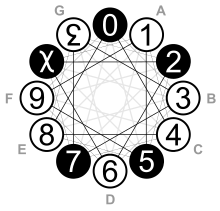File:Musical scales fingering.svg

Original file (SVG file, nominally 679 × 2,768 pixels, file size: 914 KB)
Captions
Captions
Summary[edit]
| DescriptionMusical scales fingering.svg |
 Left and right hand fingering for all musical scales The same fingering is used for relative keys. These are 24 fingerings, namely left and right hand for each of the 12 positions in the circle of fifths. These exact fingerings are meant for scales preceded and followed by the same one. The first finger of the first and the last finger of the last scale sometimes need to be adapted. E.g. for the A minor scale the A for the right hand is notated as the thumb. Obviously at the end the little finger is to be used instead. Similarly for the C minor scale (3♭) the C for the left hand is notated as the thumb, but at the beginning the ring finger is to be used instead. There are two pairs of white keys on the keyboard: B/C (3/4) and E/F (8/9) Each fingering partitions the tones of the scale in a group of three and a group of four fingers (the latter including the ring finger). The following table the fingering type by number of accidentals. (Only for 3♯ and 2♭ left and right hand use a different type.) The small additions in parentheses are meant in the following way:
|
||||||||||||||||||||||||||||||||||||
| Date | |||||||||||||||||||||||||||||||||||||
| Source | Own work | ||||||||||||||||||||||||||||||||||||
| Author |
|
||||||||||||||||||||||||||||||||||||
| Other versions |
Left and right fingering only in a circle of fifths like File:Circle of fifths, clock and tonnetz.svg |
||||||||||||||||||||||||||||||||||||
Licensing[edit]
| Public domainPublic domainfalsefalse |
| I, the copyright holder of this work, release this work into the public domain. This applies worldwide. In some countries this may not be legally possible; if so: I grant anyone the right to use this work for any purpose, without any conditions, unless such conditions are required by law. |
File history
Click on a date/time to view the file as it appeared at that time.
| Date/Time | Thumbnail | Dimensions | User | Comment | |
|---|---|---|---|---|---|
| current | 12:14, 24 February 2019 | 679 × 2,768 (914 KB) | Watchduck (talk | contribs) | User created page with UploadWizard |
You cannot overwrite this file.
File usage on Commons
There are no pages that use this file.
Metadata
This file contains additional information such as Exif metadata which may have been added by the digital camera, scanner, or software program used to create or digitize it. If the file has been modified from its original state, some details such as the timestamp may not fully reflect those of the original file. The timestamp is only as accurate as the clock in the camera, and it may be completely wrong.
| Width | 191.70079mm |
|---|---|
| Height | 781.17737mm |

